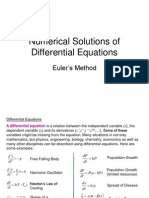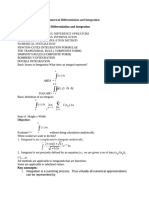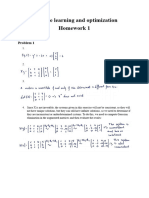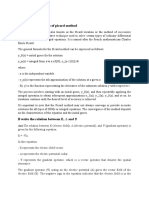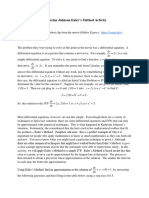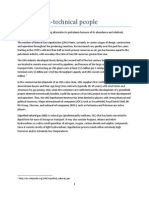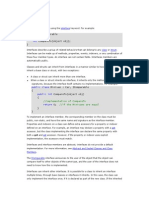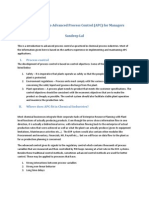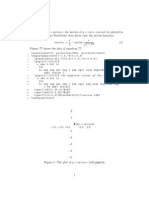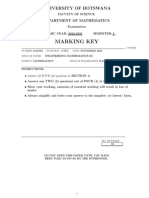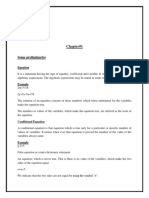Ordinary Differential Equations PDF
Ordinary Differential Equations PDF
Uploaded by
sandeep lalCopyright:
Available Formats
Ordinary Differential Equations PDF
Ordinary Differential Equations PDF
Uploaded by
sandeep lalOriginal Description:
Original Title
Copyright
Available Formats
Share this document
Did you find this document useful?
Is this content inappropriate?
Copyright:
Available Formats
Ordinary Differential Equations PDF
Ordinary Differential Equations PDF
Uploaded by
sandeep lalCopyright:
Available Formats
Ordinary differential equations
Differential equations are of the form,
dy f ( x, y) dx
with a known initial condition : y( x0 ) y0
Solutions to the above equations may be needed in two flavors,
1. Initial Value Problem (IVP) where we would like to solve the above Equation to find y for x0 <x <xfinal. 2. Boundary Value Problem (BVP) We will deal with IVP first. All algorithms work by dividing the region between x0 and xmax into a grid of N+1 discrete points at the locations x = xi, where i ranges from 0 to N. The spacing between the points may be uniform or non-uniform. The coordinate of the first node, x0 is the same as the initial point, which is also called x0. The final grid node, called xN, is located at the final value of x, xmax.
A non-uniform grid, with different spacing between different nodes, is illustrated below. ------------------------------------------~ x0 x1 x2 x3 ~----------------------- xN-2 xN-1 xN
For a uniform grid, all values of xi are the same. In this case, the uniform grid spacing, in a onedimensional problem h. I.e., h = xi xi-1 for all values of i. There are N values of hi, with i ranging from 1 to N in the definition of x. (There is one more grid point, xi, than the number of grid steps, hi.) If the grid spacing is uniform, we can calculate the value of h from the following equation.
x max x0 N
Taylor series expansion gives
y ( x 0 h) y ( x 0 )
dy 1 d2y 2 1 d3y 3 h h h .... dx 0 2! dx 2 0 3! dx 3 0
Explicit ODE Integrators: In explicit methods, yk+1 depends on previous values of x and y e.g
yk 1 y k x f ( xk , yk )
Implicit ODE Integrators:
In implicit methods, yk+1 depends on previous
values of x and y e.g
y k 1 y k x f ( xk 1 , y k 1 )
Note that the solution at the advanced point, y1; now appears on both sides of the stepping formula, and we therefore must solve a nonlinear equation to compute y1: Thus, the price we pay in general when using implcit methods is the solution of systems of nonlinear (algebraic) equations
Multistep Methods We have previously seen various methods, especially Runge-Kutta methods, which can obtain accurate solutions for the numerical integration of ordinary differential equations. However, there methods require a large amount of work per step. Several derivative evaluations are required at each step and this can increase the work if the derivatives are complex. The large number of derivative evaluations per step is required in these methods to obtain a high order truncation error. These methods have the advantage of being self-starting; the integration step from xi to xi+1 does not require any information from grid points before x xi. An alternative approach is to use information from past integration steps to derive a higher order expression for integration the differential equation. An obvious disadvantage of this approach is that the resulting methods will not be self-starting. Consequently, it will be necessary to provide some other method, such as a Runge-Kutta method, to start the integration with a multistep method. Multistep methods are usually predictor corrector methods. We have already seen an example of a predictor-corrector method in Huens method, which was a modification of the Euler method. In that method we used a predicted value of yi+1 to compute an estimate of the derivative f(xi+1, yi+1). We then used that estimated derivate to compute a final (corrected) value of yi+1. Multistep predictor-corrector methods proceed in the same way. In addition, the difference between the predictor and the corrector can be used as an estimate of the error for step-size control.
You might also like
- Ordinary Differential EquationsDocument20 pagesOrdinary Differential EquationsTony HerrysNo ratings yet
- Initial-Value Problems SPRING 2005 - Revised: y X y y X F X yDocument13 pagesInitial-Value Problems SPRING 2005 - Revised: y X y y X F X yVinay GuptaNo ratings yet
- Finite Difference Methods by LONG CHENDocument7 pagesFinite Difference Methods by LONG CHENSusana BarbosaNo ratings yet
- Project Report MathsDocument7 pagesProject Report MathsQasimbuttNo ratings yet
- Review of Numerical MethodsDocument3 pagesReview of Numerical Methodssrv srvNo ratings yet
- Intro Eigen-Value TypedDocument5 pagesIntro Eigen-Value TypedpathanshamsheerkhanNo ratings yet
- DiffEQ Basics NotesbDocument9 pagesDiffEQ Basics Notesbchristopher_kephart1No ratings yet
- The Difficult PDE Files Part 2: Numerical Methods I: 0 H B A HDocument3 pagesThe Difficult PDE Files Part 2: Numerical Methods I: 0 H B A HJustin Lynn ReidNo ratings yet
- Unit Multistep and Predictor Corrector Methods For Solving Initial Value ProblemsDocument27 pagesUnit Multistep and Predictor Corrector Methods For Solving Initial Value ProblemsJAGANNATH PRASADNo ratings yet
- Runge Kutta - MatlabDocument6 pagesRunge Kutta - MatlabAyesh Nayana GunawardanaNo ratings yet
- Numerical Solution of Ordinary Differential EquationsDocument31 pagesNumerical Solution of Ordinary Differential Equationschandu3072002100% (1)
- Ordinary Differential EquationDocument13 pagesOrdinary Differential EquationMich LadycanNo ratings yet
- Numericals For ODEDocument5 pagesNumericals For ODEtetsuyauzuiNo ratings yet
- Numerical Solution RL CircuitDocument11 pagesNumerical Solution RL CircuitSachin Kumar Bhoi0% (1)
- 3CO2 I HandoutDocument27 pages3CO2 I HandoutShahid NadeemNo ratings yet
- PRu 4Document13 pagesPRu 4Yash ShahNo ratings yet
- N S O D E: Umerical Olution OF Rdinary Ifferential QuationsDocument3 pagesN S O D E: Umerical Olution OF Rdinary Ifferential QuationsAyush BhadauriaNo ratings yet
- DivaDocument15 pagesDivadhani7No ratings yet
- X F DX Dy: Chapter 3: Numerical Methods For Ordinary Differential Equations Euler'S MethodDocument4 pagesX F DX Dy: Chapter 3: Numerical Methods For Ordinary Differential Equations Euler'S Methodems2427No ratings yet
- Nonl MechDocument59 pagesNonl MechDelila Rahmanovic DemirovicNo ratings yet
- NumericalMethods UofVDocument182 pagesNumericalMethods UofVsaladsamurai100% (1)
- Gate NumericalDocument3 pagesGate NumericalsomasekarjNo ratings yet
- Crivelli The Stormer Verlet MethodDocument14 pagesCrivelli The Stormer Verlet Methodjjj_ddd_pierreNo ratings yet
- An Introduction To Physically Based ModelingDocument124 pagesAn Introduction To Physically Based Modelingrubao_poliNo ratings yet
- Numerical Solutions of Differential Equations: Euler's MethodDocument9 pagesNumerical Solutions of Differential Equations: Euler's MethodVinayaga Murthy GNo ratings yet
- Euler's Method: Dy y y y y Fxy DX X X H y y H FxyDocument4 pagesEuler's Method: Dy y y y y Fxy DX X X H y y H FxySachin Kumar BhoiNo ratings yet
- Finite Difference Method - MatrixMethodDocument7 pagesFinite Difference Method - MatrixMethodDisha SenNo ratings yet
- FDM in MatlabDocument6 pagesFDM in Matlabzahid_rehman9574No ratings yet
- Numerical Methods For Differential Equations and ApplicationsDocument14 pagesNumerical Methods For Differential Equations and ApplicationsStefanoNo ratings yet
- Python Codes For Num Methds WTH Graph SolutionDocument141 pagesPython Codes For Num Methds WTH Graph Solutionvijay kumar honnaliNo ratings yet
- 1 Euler's Method With PythonDocument5 pages1 Euler's Method With Pythonsvedanth8No ratings yet
- Numerical Methods IDocument44 pagesNumerical Methods IMragankNo ratings yet
- 1 Euler's Method With PythonDocument5 pages1 Euler's Method With PythonThierry Rodrigues100% (1)
- Kedir Runge_kutta_ODEDocument10 pagesKedir Runge_kutta_ODEkedirNo ratings yet
- Lecture 14-OnlineDocument5 pagesLecture 14-OnlineMalik ZuraizNo ratings yet
- Eigenvalue Problems (Inverse Power Iteration With Shift Routine)Document15 pagesEigenvalue Problems (Inverse Power Iteration With Shift Routine)Dionysios ZeliosNo ratings yet
- Line AlgorithmDocument62 pagesLine AlgorithmAnonymous p8bHAAxNo ratings yet
- Homework 1Document8 pagesHomework 1Alejandro FonsecaNo ratings yet
- Partial Differential EquationsDocument18 pagesPartial Differential EquationsJuanParedesCasasNo ratings yet
- Implicit Runge-Kutta AlgorithmDocument15 pagesImplicit Runge-Kutta AlgorithmAndrés GranadosNo ratings yet
- Chapter 3Document25 pagesChapter 3Rohit GadekarNo ratings yet
- Envi Modeling Lecture Finals 1Document37 pagesEnvi Modeling Lecture Finals 1natilagacmaenelaNo ratings yet
- Ordinary Differential EquationsDocument10 pagesOrdinary Differential EquationsPriya SharmaNo ratings yet
- Numerical AnalysisDocument12 pagesNumerical AnalysiskartikeyNo ratings yet
- FEM Lecture 3 Method of Weighted ResidualsDocument10 pagesFEM Lecture 3 Method of Weighted ResidualsHuma BaigNo ratings yet
- Katherine Johnson ActivityDocument4 pagesKatherine Johnson ActivityFernando NunesNo ratings yet
- The Method of Lines: Prof. Dr. Fran Cois E. Cellier Department of Computer Science ETH ZurichDocument11 pagesThe Method of Lines: Prof. Dr. Fran Cois E. Cellier Department of Computer Science ETH ZurichdbcooperdkNo ratings yet
- Lab 03Document14 pagesLab 03Musa MohammadNo ratings yet
- Numerical Methods: Marisa Villano, Tom Fagan, Dave Fairburn, Chris Savino, David Goldberg, Daniel RaveDocument44 pagesNumerical Methods: Marisa Villano, Tom Fagan, Dave Fairburn, Chris Savino, David Goldberg, Daniel Raveanirbanpwd76No ratings yet
- Finite DifferenceDocument6 pagesFinite DifferenceVinay GuptaNo ratings yet
- Chapter 6 (1) ODE - RKDocument31 pagesChapter 6 (1) ODE - RKMuhammad FirdawsNo ratings yet
- Newton Forward and BackwardDocument39 pagesNewton Forward and BackwardRoshan ShanmughanNo ratings yet
- Ordinary Differential EquationDocument15 pagesOrdinary Differential EquationAli Asad SahuNo ratings yet
- Unit Second Order Boundary Value Problems: Structure Page NoDocument26 pagesUnit Second Order Boundary Value Problems: Structure Page NoJAGANNATH PRASADNo ratings yet
- ANA Lecture 09Document19 pagesANA Lecture 09makpowerumairharoonNo ratings yet
- Notes On First Order Equations-1Document19 pagesNotes On First Order Equations-1Tarun KarthikeyanNo ratings yet
- ODE 03 PostedDocument81 pagesODE 03 PostedJennifer GonzalezNo ratings yet
- A-level Maths Revision: Cheeky Revision ShortcutsFrom EverandA-level Maths Revision: Cheeky Revision ShortcutsRating: 3.5 out of 5 stars3.5/5 (8)
- Student Solutions Manual to Accompany Economic Dynamics in Discrete Time, second editionFrom EverandStudent Solutions Manual to Accompany Economic Dynamics in Discrete Time, second editionRating: 4.5 out of 5 stars4.5/5 (2)
- What Do I Do With This Linux BoxDocument2 pagesWhat Do I Do With This Linux Boxsandeep lalNo ratings yet
- Elbow Flow MeasurementDocument3 pagesElbow Flow Measurementsandeep lal100% (1)
- What Is Murgh Malai Tikka?Document2 pagesWhat Is Murgh Malai Tikka?sandeep lalNo ratings yet
- Nylon 6,6Document1 pageNylon 6,6sandeep lalNo ratings yet
- Interfaces (C# Programming Guide) : Interface Icomparable (Compareto (Object Obj) )Document3 pagesInterfaces (C# Programming Guide) : Interface Icomparable (Compareto (Object Obj) )sandeep lalNo ratings yet
- LNG For Non Technical PeopleDocument3 pagesLNG For Non Technical Peoplesandeep lalNo ratings yet
- Toolbox Weektwo PDFDocument7 pagesToolbox Weektwo PDFsandeep lalNo ratings yet
- Calculations in Access QueriesDocument4 pagesCalculations in Access Queriessandeep lalNo ratings yet
- Interfaces in C# PDFDocument3 pagesInterfaces in C# PDFsandeep lalNo ratings yet
- 1 02 Coco PDFDocument13 pages1 02 Coco PDFsandeep lalNo ratings yet
- Interfaces (C# Programming Guide) : Interface Icomparable (Compareto (Object Obj) )Document3 pagesInterfaces (C# Programming Guide) : Interface Icomparable (Compareto (Object Obj) )sandeep lalNo ratings yet
- Condensers: Integral CondensationDocument3 pagesCondensers: Integral Condensationsandeep lalNo ratings yet
- Fault Detection PDFDocument2 pagesFault Detection PDFsandeep lalNo ratings yet
- Vapor Liquid Equilibrium CalculationsDocument4 pagesVapor Liquid Equilibrium Calculationssandeep lal0% (1)
- Entropy and Disorder PDFDocument3 pagesEntropy and Disorder PDFsandeep lalNo ratings yet
- Dewpoint Calculation For A Multicomponent Mixture PDFDocument4 pagesDewpoint Calculation For A Multicomponent Mixture PDFsandeep lal100% (1)
- A Introduction To Advanced Process ControlDocument5 pagesA Introduction To Advanced Process Controlsandeep lal100% (1)
- A Introduction To Advanced Process Control For ManagersDocument3 pagesA Introduction To Advanced Process Control For Managerssandeep lalNo ratings yet
- ArccosDocument2 pagesArccosruben.berenguel4176No ratings yet
- (Multivariable Calculus) : Dr. Adnan Jahangir and Ms. Nadia Rehman Online Classes Spring 2020Document28 pages(Multivariable Calculus) : Dr. Adnan Jahangir and Ms. Nadia Rehman Online Classes Spring 2020Šh AbdullahNo ratings yet
- Factoring To Solve Quadratic Equations: Solve and Check Each Equation. - 9 4 - 3Document7 pagesFactoring To Solve Quadratic Equations: Solve and Check Each Equation. - 9 4 - 3Aml AmlNo ratings yet
- Function-1 (9) .PMD) PDFDocument2 pagesFunction-1 (9) .PMD) PDFJatin SinglaNo ratings yet
- Math9 Quarter1 Module21 FINAL-V3-1Document15 pagesMath9 Quarter1 Module21 FINAL-V3-1Ma. Cristina CapellanNo ratings yet
- Taylor Series Part 2Document4 pagesTaylor Series Part 2iamheretohelpNo ratings yet
- MAT517 - NLPDE - Aminul IslamDocument63 pagesMAT517 - NLPDE - Aminul Islamaminulislambulbul69No ratings yet
- Laplace Transform-Introduction and DefnitionsDocument71 pagesLaplace Transform-Introduction and DefnitionsSri Peni WijayantiNo ratings yet
- Laplace TransformationDocument8 pagesLaplace TransformationSeanne CruzNo ratings yet
- MAT391 EXAM KEY (November 2022)Document11 pagesMAT391 EXAM KEY (November 2022)lisamundanga84No ratings yet
- m2 PDFDocument3 pagesm2 PDFKarthik A KulalNo ratings yet
- Answers 4 Classroom Example 1: Source Flux Flux X S Flux Flux X T Ka Flux S X Flux FluxDocument42 pagesAnswers 4 Classroom Example 1: Source Flux Flux X S Flux Flux X T Ka Flux S X Flux FluxRuben SegarNo ratings yet
- BM KeyDocument250 pagesBM KeyAbiha AbbasNo ratings yet
- Structural DynamicsDocument3 pagesStructural Dynamics00152No ratings yet
- Senior Maths 2a SolutionsDocument91 pagesSenior Maths 2a Solutionsakrammohammed786000No ratings yet
- 2016.proceedings Cmmse 3Document4 pages2016.proceedings Cmmse 3JE Macias-DiazNo ratings yet
- One Variable Linear Equation Test Grade VIIDocument2 pagesOne Variable Linear Equation Test Grade VIIEko Budi PrasetyoNo ratings yet
- SundosDocument108 pagesSundosAhmed Raee MadehNo ratings yet
- EJERCICIODocument3 pagesEJERCICIOJuan SalasNo ratings yet
- Alg 2 t4 4Document13 pagesAlg 2 t4 4api-261379705No ratings yet
- Motion in A Straight LineDocument27 pagesMotion in A Straight LineBindu MenonNo ratings yet
- Simple Linear Equations A Through HDocument20 pagesSimple Linear Equations A Through HOyasor Ikhapo AnthonyNo ratings yet
- Symulteneous Linear Equation May 30, 2022Document4 pagesSymulteneous Linear Equation May 30, 2022ziiiNo ratings yet
- NCERT Solutions For Class 10 Maths Chapter 3 Exercise 3.5 - Free PDF 2024-25Document8 pagesNCERT Solutions For Class 10 Maths Chapter 3 Exercise 3.5 - Free PDF 2024-25professorcoinbaseNo ratings yet
- First-Order Differential Equations - Separable MethodDocument15 pagesFirst-Order Differential Equations - Separable Methodainul sofeaNo ratings yet
- Karnataka 2nd PUC Blue Print 2024Document4 pagesKarnataka 2nd PUC Blue Print 2024pavanmadar41No ratings yet
- Course Outline Math-351 Numerical MethodsDocument2 pagesCourse Outline Math-351 Numerical MethodsDawood AbdullahNo ratings yet
- Differential Equations Practice SetDocument7 pagesDifferential Equations Practice Setlbwnb.68868No ratings yet
- Week 4 - 3Document4 pagesWeek 4 - 3visiting mathematicsNo ratings yet
- CFD EM C4 FiniteDifferenceMethodDocument13 pagesCFD EM C4 FiniteDifferenceMethodMinh TrựcNo ratings yet
























